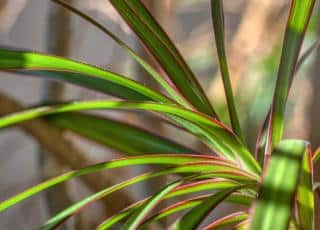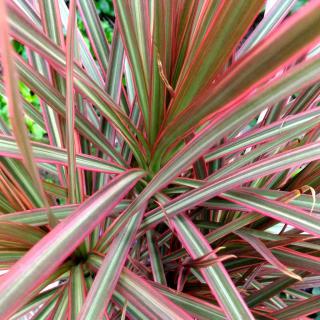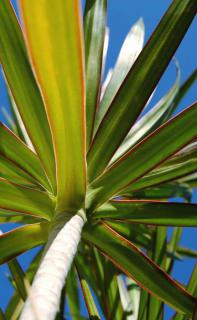

Dracaena marginata, often thought to be a palm tree, is a truly magnificent indoor plant.
Dracaena marginata facts
Name – Dracaena marginata or
Dracaena reflexa var. angustifolia
Common – Madagascar Dragon tree
Family – Agavoideae
Type – indoor plant
Height – 3 to 6 ½ feet (1 to 2 meters)
Exposure – very well-lit, even full sun
Soil: soil mix – Foliage: evergreen
Here is advice on caring for your Dracaena marginata.
>> Problems with your dragon plant? Click here <<
The Madagascar Dragon tree is a rare houseplant: it can take full sun indoors!
Growing Dracaena marginata in a pot requires good soil mix that can be amended with ⅓ compost, if you’ve got some at hand.
 In order to enhance drainage, spread clay pebbles or small stones into the pot to form a layer at the bottom.
In order to enhance drainage, spread clay pebbles or small stones into the pot to form a layer at the bottom.
This will ensure roots won’t wallow in water, which could be fatal.
 Growing dracaena marginata outdoors is only possible in warm climates because this plant can’t stand the cold.
Growing dracaena marginata outdoors is only possible in warm climates because this plant can’t stand the cold.
Just as is practiced for plants in pots, feel free to place a bed of gravel, small stones or clay pebbles to drain water out better.
 The dragon tree adapts well to living indoors in apartments and homes.
The dragon tree adapts well to living indoors in apartments and homes.
It grows best when surrounding temperatures hold at around 70 to 72°F (20 to 22°C). It requires very good light, even direct sunlight.
If you live in a dark house, avoid dracaena: it can’t cope with low light if you water too much.
However:
If the soil is allowed to dry well between waterings – almost like a cactus – all of these Dracaenas do well for years and years in low light.
– Marlie Graves, interior landscaper
If you live in tropical climates, Dracaena marginata will thrive outdoors with little or even no care.
Outdoors, you won’t have to worry very much: as long as the soil drains well, rainfall will cover the plant’s needs.
Inside, as a houseplant, remember the “seven-day rule“: optimum water is every 7 days, once a week.
The biggest trap is overwatering: your dracaena will get yellow leaves and die. Make sure soil dries out entirely before watering again.
Though clearly a look-alike, Dracaena marginata isn’t a palm tree. It’s in a category called “false palms”, plants similar to real palms like Areca palm and saw palmetto.
Luckily, the care it needs is nearly identical to that of a palm tree.
All in one aesthetic, resilient and very easy to grow, this is one of the most appreciated and successful houseplants ever.
Foliage is wispy, elegant and unique. Its shape and bearing brings a touch of exotic life to a living room, dining area, and any other room of the house that is well-lit.
Dracaena marginata has a confusing name history. The scientific name for the dragon plant is Dracaena reflexa var. angustifolia. In stores, the simpler names “Dracaena marginata” and Dragon tree prevail.
The Dracaena genus is extensive. Many cousins of Dracaena marginata are also grown as houseplants, like Dracaena massangeana.
From these, cuttings can lead to a new type of Dracaena marginata.
In recent years:
Dracaena marginata, like most houseplants, may fall victim to pests and diseases. Troubleshoot issues here:
When propagating dracaena, prepare several cuttings at a time! Chop the stem into as many 1 foot (30 cm) pieces as you can. Place in water for roots and leaves to sprout on each.
Well, I did it. I over watered and now all the leaves fell off my beautiful Pink Palms. 3 rotted but the remaining 2 might be ok. How do I ‘dry’ them out? The were SO pretty and now they are just balding stems in soil. Thanks!!
Hi V Mat, it happens – that’s experience for you! “Drying them out” means:
– no more watering
– if you feel the soil is soggy wet, then it’s really good to delicately tease the whole root ball out from the pot to let it dry out even better. This only works when there are lots of roots already, otherwise everything will fall apart. Don’t pull on the stem as you do this, better to tip the pot to the side, run a blade around the rim and twist the pot away. Set the plant upright again, let it be for 2-3 days before repotting again (this time with better drainage along the bottom).
where can i purchase dracaena marginata plants i live in SYDNEY
Hello there Graham, there are several options. Most garden stores and nurseries are sure to have the one or the other Dracaena marginata variety, but if you really want to make sure, call them beforehand so you’re not disappointed. I saw, for instance, that flowerpower had at least three or four D. marginata, they’ve got stores all over the Sydney area, but there’s lots of other stores that have them, too: palmland, gardenarium, budget wholesale nursery sydney… Nature & Garden doesn’t sell any plants, we just try to help you grow them!
mine is a long pencil thin stem with leaves hanging down and new growth that sticks out. no nodes in stem it is smooth. how can I get a shorter stronger stem. 43 ‘tall, leaves are from 33-43 hang like umbrella tree then the top ones spray out. some from 33-43 die and fall off.
Hello Bonnie, the only way to make your dracaena grow a bit thicker is to make it grow more branches. I think the nodes are there, just too small to notice: actually whenever a leaf detaches from the stem, it leaves a node behind. They’re really everywhere, but on younger plants they’re harder to see.
What you should do is behead the plant (cut the tip off). The remaining portion will grow new branches and the trunk will be thicker. Here’s a guide on how to behead a dracaena marginata.
As an interior landscaper for over 30 years, I kind of need to correct one of your statements. Saying that D. marginata, and indeed all Dracaenas, need to have a south window – high light – is (no other way to say it) wrong. We all have relied on the dracaenas, especially the marginata, massangeana, Janet Craig, and warneckei, for decades as large low-light plants. If the soil is allowed to dry well – almost like a cactus – between waterings, all of these Dracaenas do well for years and years in low light. Hope you can use this information.
Hi Marlie, your insights are very valuable. More often than not, overwatering is what kills dracaena, and placing them in full sun does reduce the risk by a lot since it’s able to evaporate excess water better. It’s true that when you water appropriately, it’ll do fine in low light, though it of course won’t grow as fast – but that’s ok when the plant is already grown to a proper size. I really thank you for your comment, I’ve corrected the article to share what you’ve said.
The stems of my dracaena are floppy
Oh, dear, it sounds like an advanced case of fungus disease, probably due to overwatering. Possibly the pot doesn’t drain well, or it sits in a saucer/pot holder that keeps water in. Or perhaps it’s watered a bit too often: once a week is almost too much already. Here’s an article on how to deal with dracaena that have floppy stems and yellow leaves.
I believe the plant I was given is a dracina, dragon plant. It seems to be doing well, although it has been dropping leaves lately and it is sticker from time to time
Is this normal?
Hello Isolde! Usually stickiness is a sign that mealybugs have appeared, this is common in houseplants. Also called scale insects, these bugs weaken the plant. There’s a full article on those right here, but in a nutshell, what I find works best is to find the bugs and dab them with a cotton bud dipped in methylated spirits or a cheap, strong, 40-proof alcohol. They’ll die off and if you repeat this two or three times at a few day’s interval, you’ll be sure not to miss any.
Dropping leaves may be a result of this weakening, or it might also reflect a change in the past month or so: did you move it? If so, losing a few leaves is just a way for it to adjust.
Another reason might be insufficient air moisture: dracaena plants aren’t palm trees, they like it when the air is moist around them. Resting the entire pot on a larger shallow plate with a bed of clay pebbles or gravel doused with water will do the trick. The water isn’t for the plant (dracaena roots don’t like to wallow in standing water), but it evaporates and creates a moist micro-climate around the pot. Remember to add water to your gravel or clay whenever it seems dry.
Hope this helps!